The redtail catfish is a beautiful species of freshwater catfish. Its grey black-spotted body and vibrant red tail inevitably draw the attention of fish lovers.
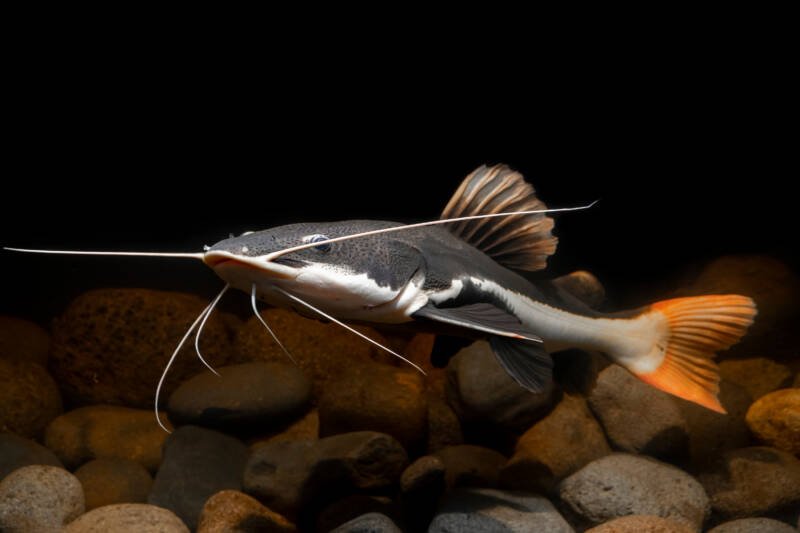
Redtail catfish (Phractocephalus hemioliopterus) is an ancient genus believed to be over 13 million years old. It’s in the family Pimelodidae, which includes whiskered catfish.
It is often nicknamed the banana catfish due to a yellowish stripe on its side.
Unfortunately, this is a species that takes a lot of time and commitment to own and properly take care of.
Beginner aquarium owners should stay away from owning this fish, and even veteran fishkeepers should reconsider. It’s a very controversial catfish in the aquarium hobbyist world.
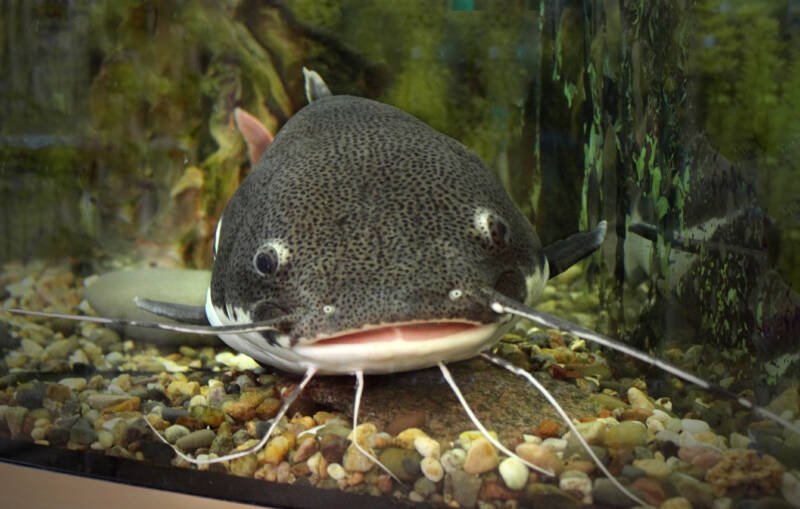
At a glance
- Care Level: difficult
- Tank Size: 1500 to 2000 gallons minimum.
- Lifespan: 15 years on average
- Size: 3 to 4 feet in length
- Temperature: 68 to 80°F
- Ph: 6 to 7.5
- Feeding Habits: omnivore, opportunistic predator
In this article
Natural Habitat
The natural habitat of the redtail catfish is originally rivers and lakes in the northern regions of South America.It can be found in countries such as Brazil, Venezuela, Peru, and Colombia.
It regularly lives in Amazonian river basins. These environments range from fast-moving water to still lakes, as long as the environment has the food source to accommodate its massive size and diet.
Under no circumstances should you dump this fish in any river or lake.
It will eat anything small enough to fit inside its mouth, which makes it extremely harmful to any environment you place it into.
It is also illegal and will result in hefty fines from your local department of game and wildlife.
Size

This fish is huge, and it requires a large amount of space to keep it healthy for its entire life.
While most pet stores will sell juveniles that start at 2 inches (5 cm), they grow at a rate of one inch per week.
The redtail catfish can grow to 3 to 4 feet in length in captivity.In the wild, they can grow up to six feet long, easily weighing 80 pounds.
Do not fall prey to the myth that fish will only grow to the size of their environment.
Appearance
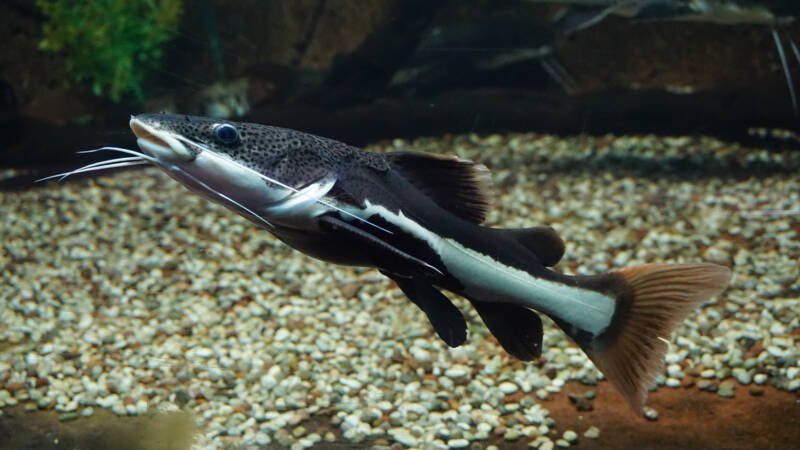
Redtail catfish are some of the most beautiful species of catfish. They have white or grey bodies covered in black spots.
There is a stripe going down the body on each side of the fish that is white or yellow, which leads to the common nickname banana catfish.
The tail of this fish can be orange or bright red, which is why it is called the redtail catfish.
They also have sets of long whiskers, or barbels, on each side of their face.
Sexing
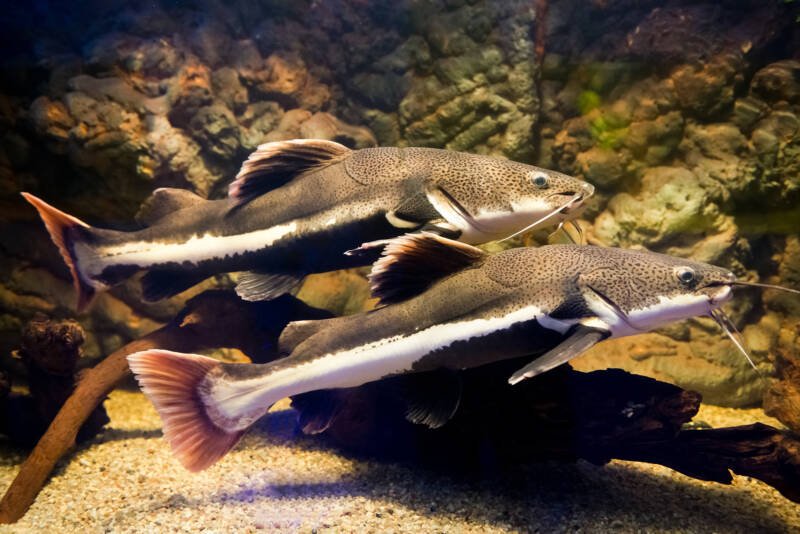
There are no external ways to tell a male or a female redtail catfish apart. Females will grow to a larger size than males.
Lifespan
If you want to keep a redtail catfish, be ready for a commitment. The average lifespan of this fish in captivity is 15 years.
In the wild, they have been known to live for around 30 years.
Since they can grow to such a large size and live so long, it can make moving this fish expensive, if not impossible.
Food and Diet
If there is one thing the redtails love to do is eat. They will eat anything that is thrown into its tank.
Even though it will eat anything, it doesn’t mean it should, though. Your catfish still needs a nutritious and varied diet.
In the wild, they eat small fish, crustaceans, insects, and vegetation that falls into their environment. Redtails are omnivorous, preferring the meaty side of the menu.
Good food options for your redtail are live worms, shrimp. You will also need to feed it large amounts of cut-up fish meat. This will help keep your catfish healthy and will mimic what it would eat in the wild.
You can also feed them a variety of pellet or frozen foods, but make sure they sink to the bottom of the tank. Catfish are naturally bottom feeders.
Stay away from feeding your fish red meats, as this can lead to weight issues.
Setting Up Your Tank
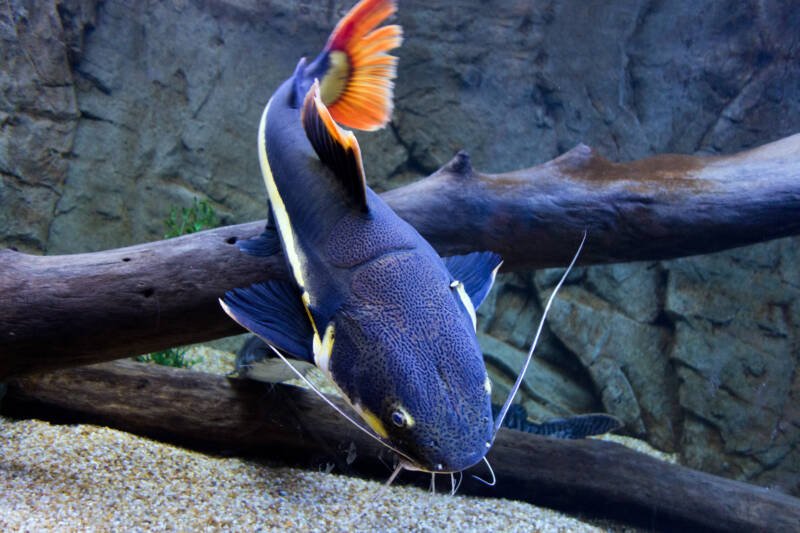
You will need a pretty substantial home aquarium to house this large fish comfortably.They require a 1500 to 2000 gallon tank at a minimum. Even that is on the small side for this catfish.
If you are serious about owning a redtail catfish, make sure you have a tank this size before purchasing the fish.
Don’t start small with the intention of upgrading to a larger tank as it grows. It grows at such a fast rate that you will have a two-foot catfish before knowing what to do with it.
The redtail catfish will also eat anything small enough to fit into its mouth, alive or not. This means you can’t have any live plants, decorations, or loose fish tank parts in its environment.
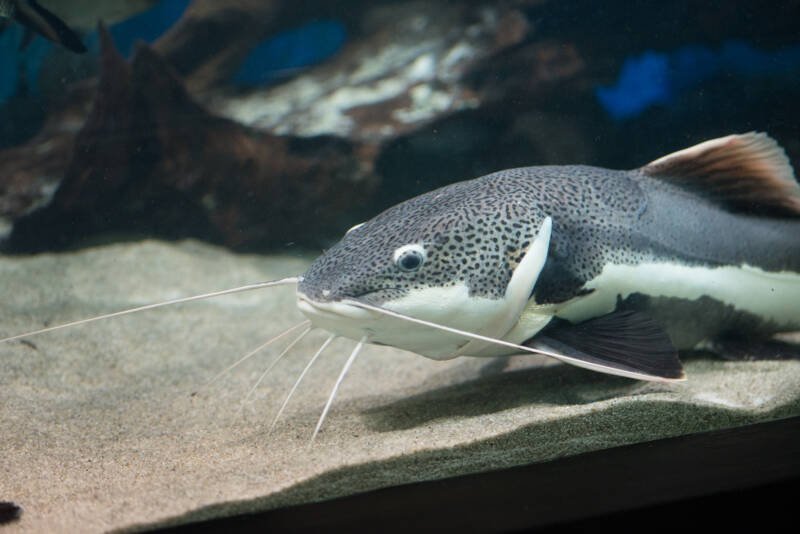
When they are young, they tend to be timid and prefer a cave to hide in but make sure it’s large enough not to be eaten.
You could have a bare bottom tank or use a layer of gravel or sand substrate.
Due to the redtail catfish living in the mid to bottom region of the tank, the sand will be moved around a lot and may lead to a murky tank.
These fish don’t require a lot of light to thrive, so that a standard lamp will be enough.
You will have to get a canister filter capable of circulating the water in a tank this size. It will also have to be enclosed as much as possible to keep the fish from attempting to eat it.
They are also very messy eaters, so your filter will need to handle that as well.
Water Conditions
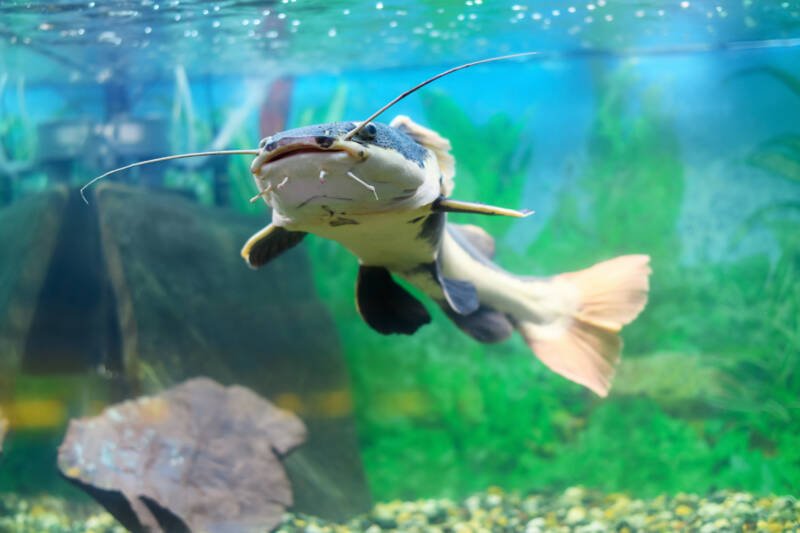
The redtails are considered hardy fish, but they still require water temperatures between 68 to 80°F.
You have to make sure your tank is heated properly, and with the large amounts of water to heat, you will need a beefy one.
As far as water conditions, you will need to watch the nitrate levels in your tank.
Redtail catfish are sensitive to high nitrate levels due to their barbels and can hinder them from navigating around the tank properly. Your nitrate levels in your tank should not be above 20 ppm.
Pond Care
If you are set on owning a redtail catfish but don’t want a large aquarium, the best thing for them is a large indoor pond set up.
This can get expensive, but it will give your fish the room it needs to live comfortably.A good-sized pond for a redtail catfish should be around 2000 gallons or larger.
Care Tips
Maintaining your tank is key to your fish’s health and safety.
Due to its messy eating habits, this fish’s tank will require frequent water changes. Due to the size of its tank, this can be a chore.
The filter will need to be maintained as well. Ensure the tank is covered or in a position that nothing can fall in and be eaten by your redtail catfish.
Redtails are usually not aggressive towards anything they don’t consider to be prey.
Certain conditions can make it display aggression toward a tank mate, such as a cramped tank environment. This will manifest in chasing and nipping at the fins of other fish.
This fish will rarely display aggression towards humans, but bites can happen if you are not careful. To a hungry catfish, your hand and fingers wiggling around in its tank will appear as an appetizing snack.
If your catfish bites you, try to stay as calm as possible and treat it like any other bite with proper first aid.
If you need to reach into the tank for any reason, it’s best to wear a thick protective glove.
Tank Mates
Redtail catfish are opportunistic predators. This makes them seem quite aggressive due to their natural predator instinct. They will attempt to eat anything small enough to fit into its mouth.
They also get territorial around other redtails, so never have more than one in a tank.
Compatible species are:
- Certain larger stingray species
- Iridescent sharks
- Large plecos
- Oscars
- Giant gouramis
- Large gar or datnoids
- Fish larger than your redtail catfish.
Do not house this fish with any smaller fish. They will get eaten, and you don’t want that.
Keeping other fish with your redtail catfish is challenging since it already requires so much room on its own. If you add another fish as a companion, it will increase the size of the tank you need.
Breeding
Breeding the redtail catfish is considered to be impossible in captivity.
These fish are often bred on farms in extremely large ponds and holding areas on lakes. The fry is large, and breeding should not be done unless it’s in the right conditions.
Closing Thoughts
This is definitely not a fish for the faint of heart. It requires quite a lot of space and resources to dedicate to just one fish.
This is a fish that is unfortunately often purchased by beginner aquarists who don’t know what they are getting into.
This leads to the fish being rehomed in a local aquarium, at best, or dumped into the local water environment.
If you are considering raising a redtail catfish, think long and hard before buying one.